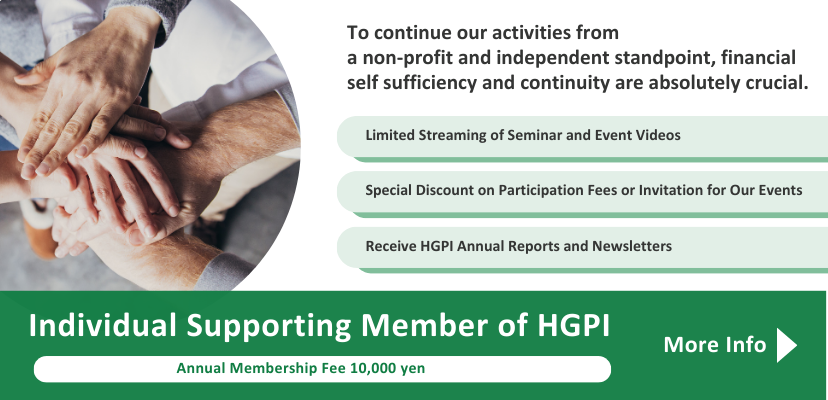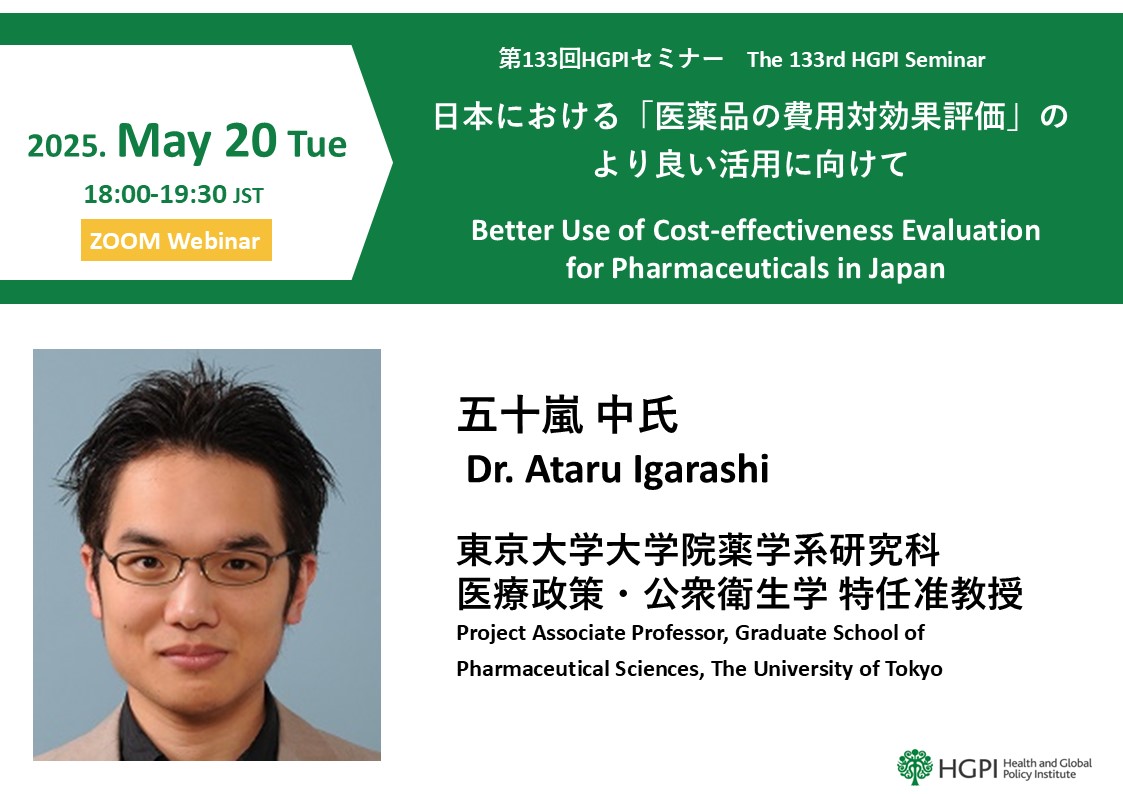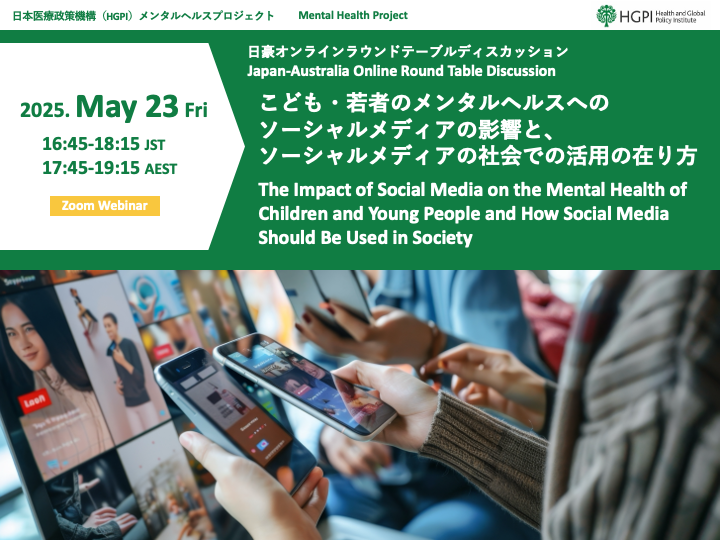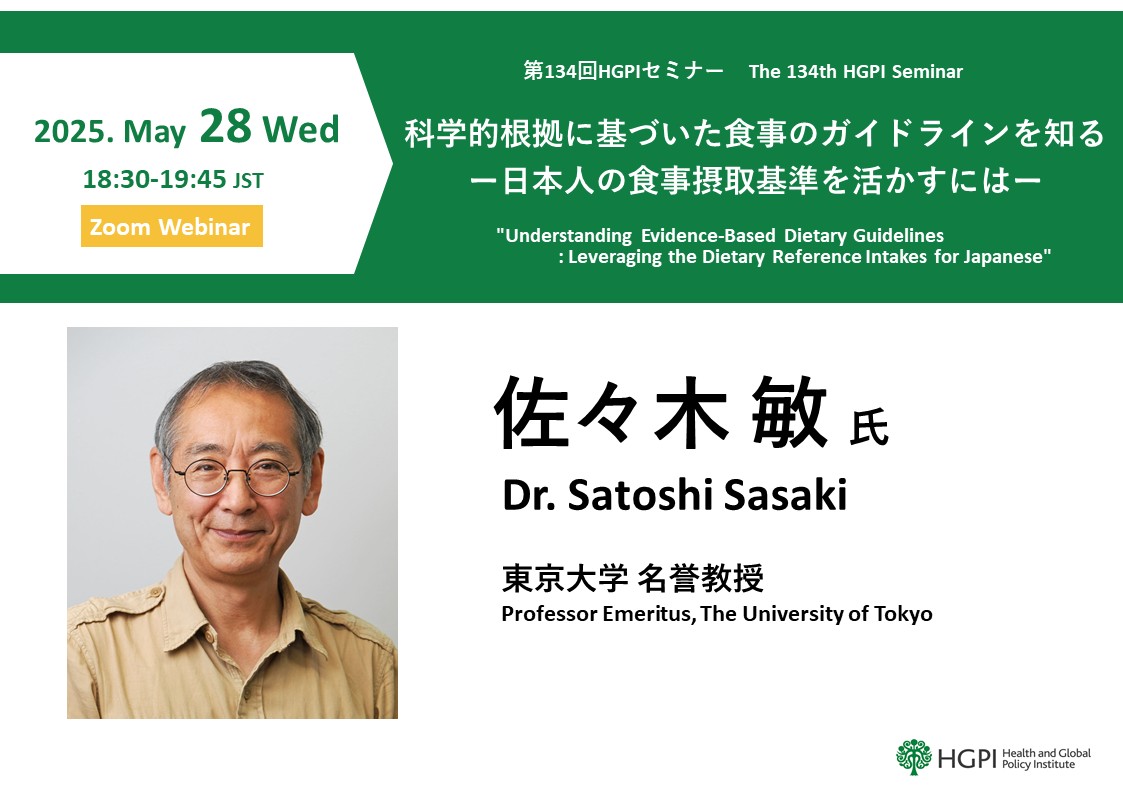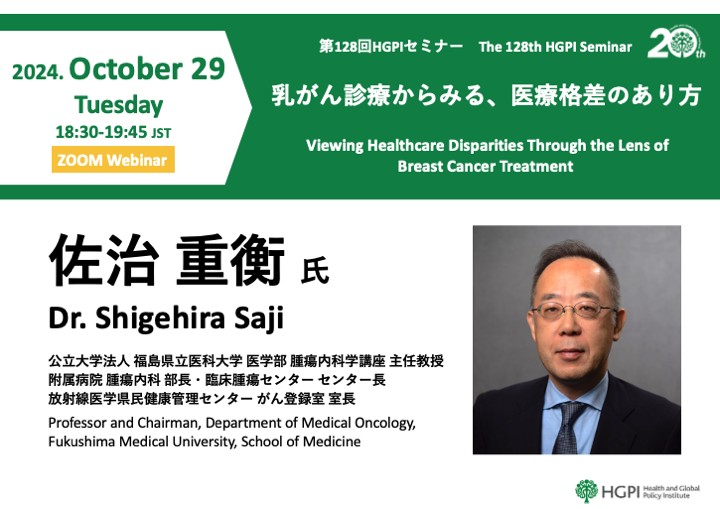[Event Report] The 127th HGPI Seminar “Current Issues and Future Prospects in Establishing a Health System and Protecting Public Health Through Policy” (July 18, 2024)
date : 5/14/2025
Tags: Future of the Health Care System, Healthcare DX, HGPI Seminar, Innovation and Sustainability
![[Event Report] The 127th HGPI Seminar “Current Issues and Future Prospects in Establishing a Health System and Protecting Public Health Through Policy” (July 18, 2024)](https://hgpi.org/en/wp-content/uploads/sites/2/HGPI_20240718_127thHGPISeminar-1.png)
For this HGPI Seminar, we welcomed Dr. Yoshiteru Yano (Health and Medical Technology Officer, General Affairs Division, Health Policy Bureau, MHLW), and discussed the history of establishing a system for primary care physician functions, various policies for improving healthcare access through online medical consultations, and future challenges based on the latest developments.
<POINTS>
- The function of primary care physicians was proposed during the social security system reform process as a necessary “gentle gatekeeper” to alleviate crowding at large hospitals
- The framework for establishing this system consists of creating a career path for physicians, establishing a Primary Care Physician Function Reporting System, and renovating the Medical Function Information Provision System
- To realize “healthcare that treats and supports” that meets the complex needs of senior citizens, a healthcare system that focuses on daily lives in communities is necessary
- While online medical consultations are expected to broaden healthcare access and synergize with primary care services, building evidence and promoting appropriate use remain challenges for their further adoption
During the social security system reform proposal process, it was suggested that primary care physicians could serve as “gentle gatekeepers” to alleviate crowding at large hospitals, and efforts are now advancing to establish a system that lowers social security spending while providing quality-focused health services that meet the complex needs of senior citizens
Given the need to maximize efficiency due to the limited nature of medical resources, one proposal that emerged during the process of gathering proposals for social security reform was that primary care physician services could be utilized to address crowding at large hospitals. In such an arrangement, primary care physicians would provide patients with initial medical examinations and referrals to large hospitals when necessary, thus allowing them to serve as “gentle gatekeepers.” The 2013 report of the National Council for Social Security System Reform discussed reform of the healthcare provision system for outpatient care and recommended advancing efforts to separate outpatient care provided by large hospitals by specialty and reinforcing the function of primary care physicians to ensure patients could receive care at clinics whenever possible. The 2020 reforms for building a social security system oriented to all generations also included proposals on expanding the scope of patients’ fixed out-of-pocket payments and further popularizing the use of primary care physicians.
Patient surveys have found that measures such as these have resulted in an overall downward trend over the past 30 years or so in the proportion of patients who are seen without referrals. In this sense, efforts to normalize the use of primary care physicians have achieved a certain degree of success. At the same time, the government as a whole is faced with pressure on national finances as the growth of social security spending is outpacing economic growth, so some say these reforms are insufficient. To address this, it has been suggested that further steps must be taken to clarify the function of primary care physicians and to establish systems that enable the full use of their services. At a 2022 meeting of the Fiscal System Council’s Sectional Subcommittee on the Financial System, the opinion was expressed that it would be impossible to achieve systemic reform of outpatient care through conventional measures like raising awareness among citizens or spreading best practices horizontally, and that it would be necessary to reinforce measures to transition from the existing form of free access which emphasizes “people visiting anywhere they like, whenever they want” to one that emphasizes “people seeking the care they need when they need it.” It has also been proposed that Japan expand the fixed out-of-pocket payment system for patients to include outpatient care and introduce a system similar to other countries in which patients must pay fixed out-of-pocket fees when visiting a health institution other than the one registered as their primary care provider.
There were multiple challenges to arriving at policy decisions regarding the function of primary care physicians. These included confusion over introducing a system for registering primary care physicians in advance, difficulties in setting a direction without uniform recognition of “primary care physician” among both care providers and recipients, and lack of evidence for how such a system could reduce health expenditures. Given these challenges, the Government’s approach to establishing this system was discussed once again in the December 2022 report of the Council for a Social Security System Oriented to All Generations. In addition to clarifying that the purpose of establishing such a system was to meet the need to address healthcare for senior citizens, its objective was defined as improving health services rather than reducing healthcare spending.
In addition to creating a career path for physicians, other major pillars of the framework of a system that makes full use of primary care physicians include creating a “Primary Care Physician Function Reporting System” and renovating the Medical Function Information Provision System. These plans include defining the necessary functions of primary care physicians that communities need – for example, to serve as sources of routine healthcare or consultations on health management that are easily accessible in communities. Another plan is to reinforce information provision services for citizens by creating a reporting system to reform systems surrounding healthcare providers. One reason for this is the increase in the number of senior citizens age 85 years and over and with long-term care requirement certification. While keeping the increase in senior citizens with multiple chronic diseases or complex healthcare needs in mind, transitioning from “healthcare that treats” to “healthcare that treats and supports” will require a healthcare system that focuses on how to maintain quality of life, and on the daily lives of senior citizens in communities.
A number of proposals have been suggested in discussions on the reporting system for primary care physician services. One recommendation is to examine what knowledge (gained through study) and experience (gained through on-the-job training) regarding primary care must be covered during training, and then to present who has completed training or to introduce a search function for primary care services to the health information platform. This would make it easier for people to understand which healthcare professionals have completed training in primary care. As for training physicians, one school of thought is to train more general practitioners who can support communities by watching over patients and their families with a broad perspective and serve as primary care physicians. Another option may be to train organ specialists on primary care through recurrent education so they can provide the care that will be needed in the future. To foster physicians who can meet the medical needs of senior citizens, we must secure the primary care physician services that communities need through government support and on-the-job training at local health institutions.
Expectations are high for online medical consultations to broaden care access through advances in ICT and to synergize with primary care services, but they face future challenges for further widespread adoption, such as building evidence and promoting appropriate use
Advances in information and communication technology (ICT) or changes in regional healthcare provision systems and healthcare needs have driven increased demand in recent years for online medical consultations using information and communication devices to improve patient access to healthcare. Because online medical consultations require mutual trust (such as when a physician requests necessary information from a patient, or when a patient must approve a physician’s treatment plan), online medical consultations are especially compatible with the function of primary care physicians. While we saw a great expansion in online medical consultations during the COVID-19 pandemic, most of those consultations covered items related to infectious diseases, such as fever or upper respiratory tract infections. As has been pointed out, this did not result in the widespread adoption of online medical consultations, and that there are now cases in which online medical consultations are not being used appropriately. Steps must be taken to promote understanding among both health professionals and patients.
The use of online medical consultations has mainly expanded with changes in interpretations of Article 20 of the Medical Practitioners’ Act, which bans activities like providing medical care without a personal examination. A 1997 decision found that online medical consultations provided to residents of remote islands or areas would not violate this Article. A later interpretation in 2015 stated that remote islands or areas were only examples, and that online medical consultations are not in violation of this article when enough patient information to replace an in-person medical consultation can be obtained. In 2018, the MHLW formulated the “Guidelines for the Appropriate Implementation of Online Medical Care,” which led to the inclusion of items in the medical service fee schedule, such as a premium for online medical consultations. Furthermore, in the past, online medical consultations were exclusively for follow-up consultations, but in response to the COVID-19 pandemic, it became possible for initial visits to be provided through online medical consultations, as well.
For patients, the adoption of online medical consultations is likely to elevate healthcare quality while improving access. For physicians, online medical consultations have been assigned new premiums in the medical service fee schedule, and relaxations of the Medical Care Act are making it possible to establish clinics for online medical consultations to serve isolated regions and other areas without full-time physicians. However, moves to deregulate have advanced before online medical consultations could become established as a standard form of care, leading to a growing number of problems, particularly in aesthetic medicine. To properly promote online medical consultations, it will be important to gather and establish evidence, which will include compiling best practices under the leadership of local governments as well as conducting research and creating guidelines under the leadership of health institutions.
[Event Overview]
- Speaker:
Dr. Yoshiteru Yano (Health and Medical Technology Officer, General Affairs Division, Health Policy Bureau, MHLW) - Date & Time: Thursday, July 18, 2024; 18:30 – 19:45 JST
- Format: Online (Zoom webinar)
- Language: Japanese
- Participation Fee: Free
- Capacity: 500 participants
■Profile
Dr. Yoshiteru Yano (Health and Medical Technology Officer, General Affairs Division, Health Policy Bureau, MHLW)
Dr. Yoshiteru Yano is a graduate of the Kyoto University Graduate School of Medicine and Faculty of Medicine. His past roles at the MHLW include serving in the Medical Economics Division of the Health Insurance Bureau, where he took part in medical service fee schedule revisions; the Research and Development Division of the Health Policy Bureau, where he worked for the promotion of clinical research; and the Policy Planning Division of the Department of Health and Welfare for Persons with Disabilities, where his duties involved welfare for people living with disabilities. He has also been seconded to the Ministry of the Environment, the Miyazaki Prefectural Government, and the U.S. Department of Health and Human Services. He assumed his current position in July 2022, where his current responsibilities include the general management of technology projects in health policy, promoting family doctor services and online medical consultations, and medical advertising. Dr. Yano is a medical doctor and holds a Doctorate in Health Policy and Informatics from Tokyo Medical and Dental University.
Top Research & Recommendations Posts
- [Research Report] Perceptions, Knowledge, Actions and Perspectives of Healthcare Organizations in Japan in Relation to Climate Change and Health: A Cross-Sectional Study (November 13, 2025)
- [Research Report] The 2025 Public Opinion Survey on Healthcare in Japan (March 17, 2025)
- [Policy Recommendations] Mental Health Project: Recommendations on Three Issues in the Area of Mental Health (July 4, 2025)
- [Policy Recommendations] Developing a National Health and Climate Strategy for Japan (June 26, 2024)
- [Research Report] The 2023 Public Opinion Survey on Satisfaction in Healthcare in Japan and Healthcare Applications of Generative AI (January 11, 2024)
- [Policy Recommendations] Recommendations on Strategic Investments in Policies for Brain Health to Revitalize Japan: Hopes for the New Administration (December 1, 2025)
- [Policy Recommendations] Reshaping Japan’s Immunization Policy for Life Course Coverage and Vaccine Equity: Challenges and Prospects for an Era of Prevention and Health Promotion (April 25, 2025)
- [Announcement] HGPI Endorses the “Belém Health Action Plan” (November 14, 2025)
- [Announcement] HGPI Joins Global Green and Healthy Hospitals (August 1, 2023)
- [Research Report] AMR Policy Update #2: WHO’s First Report on Fungal Infection—Bridging the Gap Between Clinical Practice and R&D
Featured Posts
-
2025-12-09
[Event Report] Special Seminar “Rising to New Challenges in Health Sciences for Future Society: Novel Developments in the Field of Epilepsy in Japan and Globally” Belgium Pavilion Special Seminar, World Expo 2025 Osaka, Kansai (September 18, 2025)
![[Event Report] Special Seminar “Rising to New Challenges in Health Sciences for Future Society: Novel Developments in the Field of Epilepsy in Japan and Globally” Belgium Pavilion Special Seminar, World Expo 2025 Osaka, Kansai (September 18, 2025)](https://hgpi.org/en/wp-content/uploads/sites/2/HGPI_20250805_mental-health-expo-eyechatch.png)
-
2025-12-11
[Event Report] Core Components of Universal Health Coverage (UHC): Achieving “Healthcare Without Financial Hardship” in Asia-Pacific and Japan (December 5, 2025)
![[Event Report] Core Components of Universal Health Coverage (UHC): Achieving “Healthcare Without Financial Hardship” in Asia-Pacific and Japan (December 5, 2025)](https://hgpi.org/en/wp-content/uploads/sites/2/HGPI_20251210_Core-Components-of-Universal-Health-CoverageUHC-top.jpg)
-
2025-12-12
[Registration Open] Meaningful Involvement Promotion Project Urgent Symposium “The New Takaichi Administration and Central Social Insurance Medical Council Reform – Ensuring Patients’ Voices are Heard” (January 22, 2026)
![[Registration Open] Meaningful Involvement Promotion Project Urgent Symposium “The New Takaichi Administration and Central Social Insurance Medical Council Reform – Ensuring Patients’ Voices are Heard” (January 22, 2026)](https://hgpi.org/en/wp-content/uploads/sites/2/HGPI_20251208_urgent-symposium-1.png)
-
2025-12-12
[Registration Open] (Webinar) The 140th HGPI Seminar “Early Detection to Reduce COPD Disease Burden: Connecting Clinical Frontiers with Health Policy” (January 27, 2026)
![[Registration Open] (Webinar) The 140th HGPI Seminar “Early Detection to Reduce COPD Disease Burden: Connecting Clinical Frontiers with Health Policy” (January 27, 2026)](https://hgpi.org/en/wp-content/uploads/sites/2/hs140-top.png)
-
2025-12-16
[Discussion Points] Policy Dialogue “Considering Comprehensive Genomic Profiling from the Perspective of Patient Access: Utilizing the Medical Service Fee Reimbursement System and the Mixed Medical Services Program to Meet the Needs of Today” (November 28, 2025)
![[Discussion Points] Policy Dialogue “Considering Comprehensive Genomic Profiling from the Perspective of Patient Access: Utilizing the Medical Service Fee Reimbursement System and the Mixed Medical Services Program to Meet the Needs of Today” (November 28, 2025)](https://hgpi.org/en/wp-content/uploads/sites/2/eyecatch_Policy-Dialogue_Discussion-Points_20251128.jpg)





